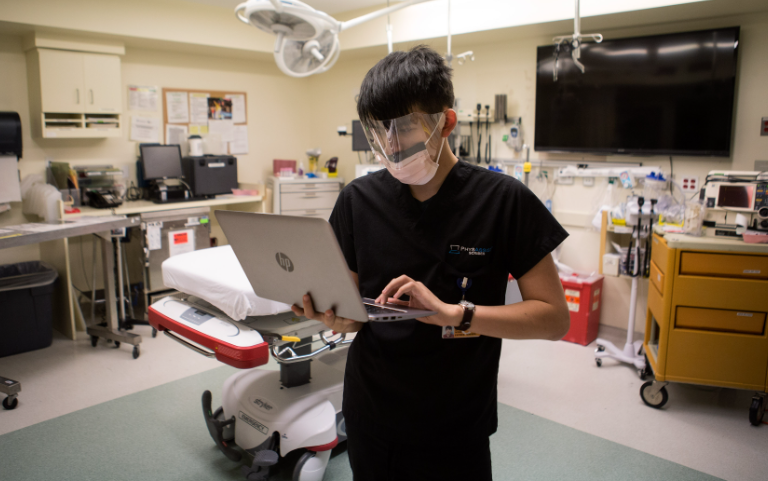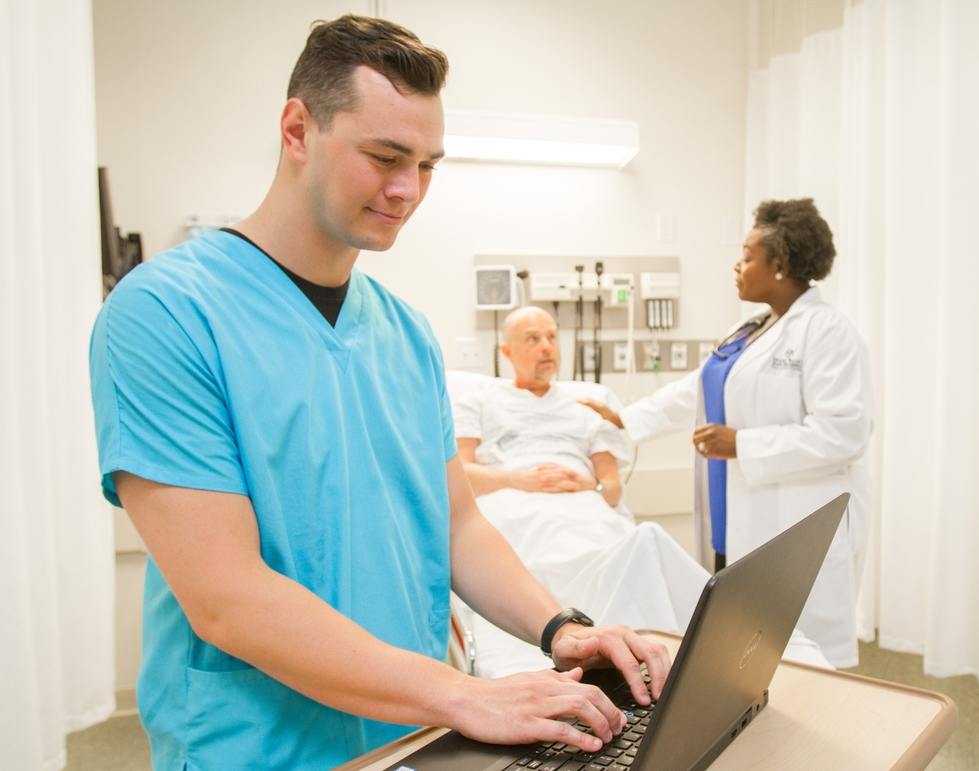One of the very first things medical students at The University of Arizona College of Medicine – Phoenix are taught is that patients want their doctors to be approachable. The need to focus on patient rapport is emphasized very early in medical training, and said need is the reason many programs include sections on communication and patient satisfaction. Studies have shown that physicians should focus on certain behaviors to build trust and connect to their patients early in their relationships, such as providing reassurance often, encouraging patient questions, avoiding judgmental behaviors and language, and more [1]. Many of these methods require the physician’s full attention to be on the patient. However, true one-on-one interactions can often become difficult to consistently have when physicians must focus on ticking off each point on their documentation checklists. In my experience, this type of scenario is where medical scribes can make all the difference.
I worked as a medical scribe for orthopedic surgeons prior to medical school, and the job made something very apparent to me: encounter documentation is extremely detail-oriented and thorough. My fellow scribes and I often had to stay behind after the physicians had left the clinic to update encounter notes and make corrections in charts. Statistics have shown that for every hour physicians have face-to-face with patients, they spend two on desk work and EHRs [2]. Those statistics do not even address the additional effects mid-encounter documentation can have on the appointment quality. From a patient’s perspective, documentation can make it seem that physicians are more focused on their computers than their patients. Ultimately, it is my belief that scribes can solve many of these problems for both physicians and patients.
Utilizing scribe services can help strongly combat documentation-related issues faced by physicians. Many studies have found that scribes increase physician efficiency and productivity by shortening overall encounter times and reducing time spent completing notes [3], decreasing time spent charting after-hours [4], and allowing more total patients to be seen [5]. Interestingly, studies had variable results regarding patient satisfaction. Some merely indicated that satisfaction did not decrease notably [4] or change very much at all in the presence of scribes [2], while others indicated that many patients were comfortable with a scribe’s presence [6] and felt more satisfied during encounters with scribes involved [7]. For example, a benefit associated with scribes described in one study was that the patients perceived their physicians as paying them additional attention [8]. It is possible that the varying results depend on how patient satisfaction is assessed or on how different clinics might utilize scribes differently, although more likely it has to do with the lack of large scale studies on the topic, as many of the studies exploring scribe impact have relatively small samples of both participating scribes and physicians. Regardless, scribes appear to frequently improve the productivity of physicians and will often either slightly improve or not affect patient experiences. Anecdotally, there was a greater degree of engagement between the physicians I scribed for and their patients (apparent through increased eye contact and patient engagement) than I was accustomed to seeing in my general shadowing and volunteering. While the data so far has been promising, it is difficult to truly assess the impact of medical scribes without more robust research. I am personally hopeful that continued research may reveal concrete evidence that scribes can help greatly improve the patient side of medical encounters.
Of course, not all clinics use scribes– many locations believe they are not always economically viable to hire. However, research has shown that for many specialties the increase in productivity provided by scribes allows physicians to see more patients and offset costs [9]. Even without taking into account the economic variables, it is clear that medical scribes provide a number of benefits in the workplace. Scribing is also an outstanding opportunity for medical and premedical students to directly learn from and observe physicians while improving physician efficiency and potentially helping patients get more of the attention they deserve. A study from 2017 estimated that by 2020 there would be one scribe in use for every nine physicians [2]. Scribes have a great deal to offer the medical world, and I for one am pleased to see their numbers increasing. Further researching the impact scribes create and training a greater number of scribes may lead to more amazing future doctors, less stressed current physicians, and many happier patients.
References
- Dang BN, Westbrook RA, Njue SM, Giordano TP. Building trust and rapport early in the new doctor-patient relationship: a longitudinal qualitative study. BMC Med Educ. 2017;17(1):32. Published 2017 Feb 2.
- Gidwani R, Nguyen C, Kofoed A, et al. Impact of Scribes on Physician Satisfaction, Patient Satisfaction, and Charting Efficiency: A Randomized Controlled Trial. Ann Fam Med. 2017;15(5):427-433.
- Rahhal R, Goad L, Bishop W. Impact of a Medical Scribe Program on Outpatient Pediatric Gastroenterology Clinic. J Pediatr Gastroenterol Nutr. 2021;72(2):220-225.
- Taylor KA, McQuilkin D, Hughes RG. Medical Scribe Impact on Patient and Provider Experience. Mil Med. 2019;184(9-10):388-393.
- Walker K, Ben-Meir M, Dunlop W, et al. Impact of scribes on emergency medicine doctors’ productivity and patient throughput: multicentre randomised trial. BMJ. 2019;364:l121. Published 2019 Jan 30.
- Koshy S, Feustel PJ, Hong M, Kogan BA. Scribes in an ambulatory urology practice: patient and physician satisfaction. J Urol. 2010;184(1):258-262.
- Bastani A, Shaqiri B, Palomba K, Bananno D, Anderson W. An ED scribe program is able to improve throughput time and patient satisfaction. Am J Emerg Med. 2014;32(5):399-402.
- Yan C, Rose S, Rothberg MB, Mercer MB, Goodman K, Misra-Hebert AD. Physician, Scribe, and Patient Perspectives on Clinical Scribes in Primary Care. J Gen Intern Med. 2016;31(9):990-995.
- Milksanek TJ, Skandari MR, Ham SA, et al. The Productivity Requirements of Implementing a Medical Scribe Program. Ann Intern Med. 2021;174(1):1-7.
Salman Azfar is a fourth year student at the University of Arizona, College of Medicine Phoenix. He graduated from UCLA in 2020 with a degree in Physiological Science. He loves dodgeball, swimming, playing games, and spending time with his friends and family. He can be reached at smazfar@arizona.edu.



